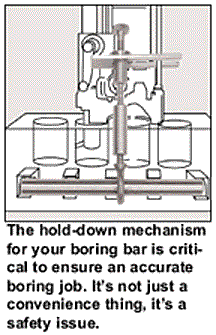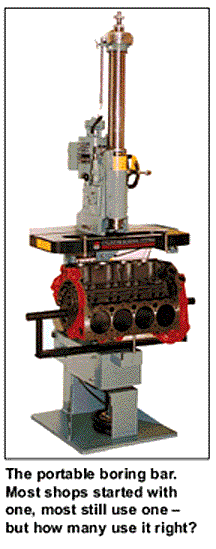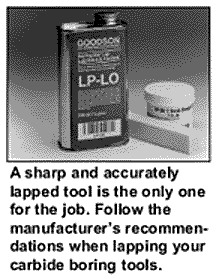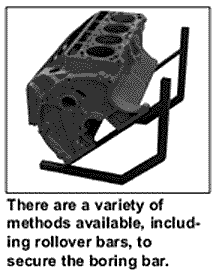You know the feeling: the machine you want, you can’t afford, and the machine you can afford you already have. Don’t you wish, just once, you could call up the sales representative and say “My turn, send me one of those new ‘XYZ’ machines?”
You know the kind, the new state-of-the-art machining center that can do exact center-to-center boring, deck surfacing, main and cam align boring, and more with, I might add, only the touch of a button. I hear one machine manufacturer is actually offering a machine with a built in coffee maker. I guess it keeps your machinist wide-awake as this automatic, robotic, 21st century machine goes through its paces.
But I digress – this article isn’t about your fantasy boring bar, it’s about your first boring bar, the one most of today’s machine shops started with and a lot still use today – the portable boring bar.

Portable boring bars have been around for a long time. Now let’s see. Who was first? Some say it was Van Norman, some say it was Rottler, and then again maybe it was Kwik-Way. Who was first?
My sources say that the first portable boring bar came into the engine market back in the early 1920s. Here’s my challenge to you…find out who was the first in the market and email me the answer at [email protected]. The first person with the correct answer will receive not only a hat and t-shirt, but a mention in the next Engine Builder Machine Maintenance column.
One other bit of detail – Kwik-Way is currently the only portable boring bar still being made today in the good old US of A!
Ok, enough with the history lesson: let’s get to the point of this article.
These so-called portable boring bars aren’t as portable as the name would imply. These bad boys are heavy-duty to withstand years of everyday use. They each have their own operation and maintenance guidelines but safety standards are the same regardless of the make and model you have. Make sure you have an overhead hoist to safely and securely move the bar to where you need it. You know me, safety first (and don’t forget your towel)!
Next, be sure you have a well-ventilated area because the dust could be combustible and even explosive. I also strongly recommend you wear a respirator and eye protection! I know it looks dorky but wouldn’t you rather look dorky than lose an eye or get a lung full of cast iron dust?

One of your biggest safety concerns is how you’ll secure the block during the boring process. There are a variety of ways to do this, like roll over bars, or welded frame-type supports, but I personally prefer boring tables for a couple of reasons. First, they do a great job of holding the engine block in position and, second, you can move the boring bar from cylinder to cylinder much more easily. Whatever method you choose, always double check to make sure that the block is not going to move while you’re boring out that cylinder.
Instruction Manuals
If you don’t have an instruction or maintenance manual, get one ASAP. Manufacturers produce these manuals for a reason – so you can use their machines properly. Make sure you have one for every machine in your shop, and keep them in an organized file for easy access.
Maintaining your portable boring bar is relatively simple as long as you have a regular maintenance schedule. In fact, this is something you should have for every machine in your shop. Protect your investment and it won’t let you down when an important job (and they’re all important jobs) comes into the shop.
Portable boring bars are designed to be mounted to the deck surface of the engine block. The hold-down mechanism for your boring bar is critical to ensure an accurate boring job. Rule of thumb here is to never allow the boring tip to come in contact with your hold down assembly. In addition, these hold down clamps are designed to be very effective in clamping without putting a 3-foot helper bar on the wrench to tighten it down. Too much over-wrenching can cause an out-of-round condition when you bore a cylinder (more on that later). Be sure to follow the manufacturer’s recommendations on how to properly secure your boring bar to the engine block.
Lubrication
Most portable machines have an oil reservoir that needs to be checked regularly. I recommend checking the oil levels at least every 30 days. Again, your operator’s manual will provide the location and recommended type of oil to be used in the system. Most motor and drive pulley bearings are sealed for life and will not need additional lubrication. However, use your ears, as they are the best judges of when something doesn’t sound right. When you hear something that sounds wrong, stop and check it out BEFORE it creates a real problem.
Most machines have those snap lid type oilers for the hand wheel and centering expanders. Set up a regular inspection and lubrication schedule for these components. The feed screw is lubricated by occasionally squirting oil directly onto it. Not too much though; you don’t want it leaking onto the floor or attracting dust and grit. Most spindle bearings are sealed and require no additional lubrication. But, as always, check your manual.
Protect the base of your portable boring bar. Its accuracy depends on how well you take care of that machined surface when moving the bar from job to job. Never set the bar on a rough or hard surface. I recommend you use soft wood or cardboard to store your bar when not in use.
A Hot Tip on the Tip
The tool bit set-up is critically important, but without properly sharpening the tool bit you’ll never get a cylinder bore that is round, straight and on size.
Every manufacturer has a somewhat different procedure for sharpening the carbide tip. Follow your manufacturer’s instructions to ensure your tip is set accurately. Always clean the boring head with a brush prior to inserting the tool holder.
I also recommend that you do a test bore on a junk or test block to confirm your settings are correct. Once you’ve confirmed your settings, you can confidently start your customer’s job.

Tungsten carbide is the material of choice for all boring applications. It is an extremely hard, yet brittle material and must be handled with great care at all times. A sharp and accurately lapped tool is the only one for the job. Follow the manufacturer’s recommendations when lapping your carbide boring tools.
Lapping itself is pretty straightforward. Dab a bit of lapping oil onto the diamond lap, smear it around with your finger, and wipe off any excess. Some laps have a felt wick that keeps oil in contact with the diamond. Never attempt to lap a carbide tool without lapping oil. It will ruin your very expensive diamond lap and do a terrible job of sharpening your tool. Occasionally the diamond disc will be clogged or gummed up. When this happens use a little cleaning solvent and then re-oil your lap with a high quality lapping oil. There is also a diamond dust paste, often called Lap Renew that will give additional life to your lapping disc and keep it working until you can get a new one.

A good eye combined with a steady hand and, of course, great lighting will go a long way in how well your tools lap in. A sharp, free-cutting tool requires less force and maintains a consistent bore size. The time needed to keep this tool sharp is greatly decreased due to your original detail when sharpening. Most of the time you should be able to bore at least 6 holes without resharpening or touching up the tool. Always keep your dial bore gauge handy to measure the size of each and every bore, and make corrections to your tool’s sharpness as well as its diameter.
A Few Words of Advice
Never allow the boring tip to strike the work piece when lowering the boring head into position. Never cut more material than is recommended by the manufacturer. This will shorten the life of the tip as well as potentially create a very unsafe condition if the tip were to be lodged in the bore during the boring process, throwing the bar off the work piece and onto the floor or worse onto you.
Chatter is generally cause by several things you should be aware of:
Sleeve bearing adjustment too loose;
Tool tip needs lapping or sharpening;
Tool tip angle too wide; or
Top of engine block not de-burred, preventing the bar from seating properly.
Out-Of-Round Cylinders
Is the whole length of bore out-of-round? This is caused by over-clamping the hold-down mechanism to the engine block, which will distort the cylinder you are boring. If you are out of round at the bottom but not the top, this is generally caused by the sleeve bearing adjustment. Double check this adjustment and make any necessary corrections.
Variations in Bore Size
Most of time, this is the fault of the operator. Recheck the tool setting procedure and insure you are not over tightening the micrometer during the setting process. Be CONSISTENT.
The quality of your carbide tip should never be compromised, so use only the highest quality carbide you can find. Make sure your micrometer is calibrated and check this every day. Look closely at the anvil in your setting micrometer. If its face is scratched or deeply burred, either send it to the manufacturer for refurbishing or replace it entirely. And, of course, recalibrate your micrometer before using it again.
The portable boring bar can be a very reliable machine for boring a multitude of applications, if you spend the time to maintain it. If you choose to not take the time for maintenance it will surely cost you a job or worse yet…a customer!
I want to thank Kwik-Way for their input in assisting me in writing this article, as well as the fine folks at Rottler Mfg., and Ken Slicer for providing me the history of portable boring bars.
See ya in the shop!













